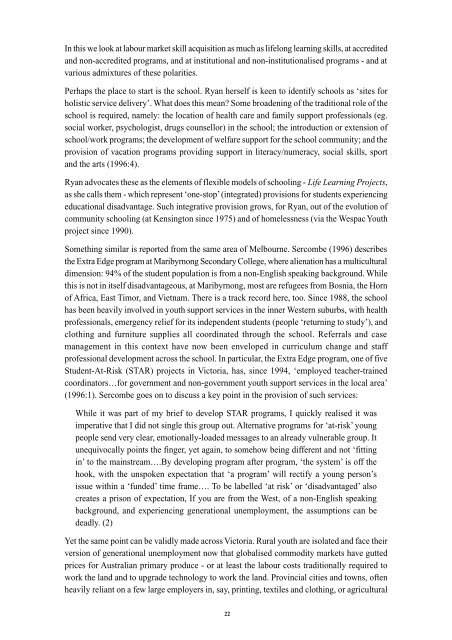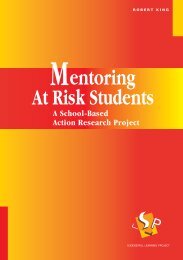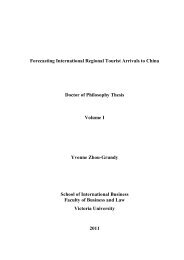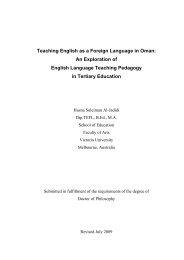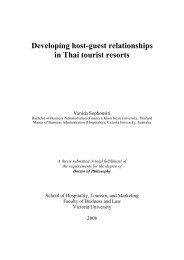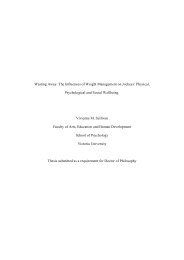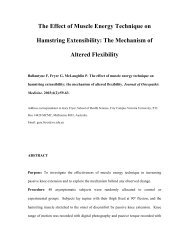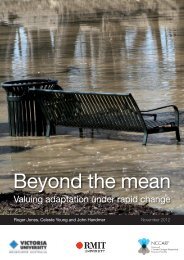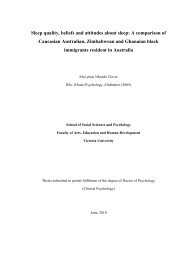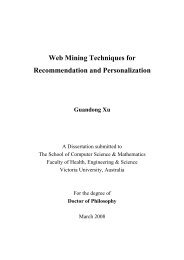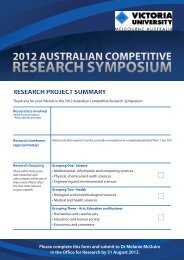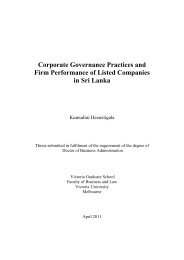Synthesising ComplexitiesThe complexity of alienation, <strong>and</strong> trying to turn that complexity to the better provisionof programs, is a consistent theme in the literature. For example, a prominent Melbourneresearcher wrote:Supporting disadvantaged families <strong>and</strong> young people is about building linkages <strong>and</strong>breaking down barriers. Interprofessional collaboration will bring with it anacknowledgment that disadvantage is seldom one-dimensional. Rather, young people<strong>and</strong> families are placed at risk by a range of traditionally-labelled education, welfare<strong>and</strong> health issues that compound their disadvantage.In these remarks, Maureen Ryan (1996: 3) identifies by implication the central current problemin mapping provisions <strong>for</strong> ‘at risk’, or ‘alienated’ young people. It is this: an integrated, holisticapproach is required, yet the very nature of ‘alienation’ is apparent in dis-integrative, fragmentedexperiences, which cut young people off from successful involvement with major socialinstitutions.Whether or not ‘alienation’ is an implicit judgement from amongst the socio-culturalmainstream, against which swim strong <strong>and</strong> viable youth cultures <strong>and</strong> sub-cultures, is outsidethe scope of this research project. There is a debate about the theorisation of youth culture(s)which revolves around the resort to totalising (all-encompassing) explanations <strong>for</strong> alienation,such as Marxism, <strong>and</strong> some versions of feminism may be regarded as exemplifying (White1993). Perhaps two consequences of various totalising explanations of alienation are thecontrasting tendencies in some research, <strong>and</strong> certainly in the mass media, to either romanticiseyouth (vox pops on ‘green’ issues, on global peace, on personal relationships) or to demonisethem (the pathology of ‘street kids’).This project endorses Kerry Carrington’s view (in White: Ch 5) that:…the major difficulty I have with cultural studies as a theoretical model <strong>for</strong> analysingthe policing of youth sub-cultures [is] its over-reliance on totalising conceptions ofpower <strong>and</strong> social control [which] attributes a false unity of purpose to the diverse sites<strong>and</strong> agencies involved in the regulation (or government) of youth. Social concern aboutyouth <strong>and</strong> their participation in youth culture is not necessarily a repressive activity.(29)Carrington goes on to list the many justified ‘policing’ activities these diverse agencies (suchas charities, schools, churches, neighbourhood centres, youth refuges, gay <strong>and</strong> lesbian groups<strong>and</strong> many state bodies) actually per<strong>for</strong>m:Homophobic, racial <strong>and</strong> sexual violence, unsafe sex, excessive drug-taking, petrolsniffing,attempted suicide <strong>and</strong> other <strong>for</strong>ms of self-destructive conduct…regularly occurin the context of young people participating in the exploits of youth culture. (29)Our interest is in the educational significance of young peoples’ alienation, against a backgroundof experiences, which frequently are destructive. So our focus is ineluctably interventionist:what learning programs can be identified - <strong>and</strong> what general features do the successful programspossess - which enable alienated or ‘at risk’ young people move beyond their circumstances?21
In this we look at labour market skill acquisition as much as lifelong learning skills, at accredited<strong>and</strong> non-accredited programs, <strong>and</strong> at institutional <strong>and</strong> non-institutionalised programs - <strong>and</strong> atvarious admixtures of these polarities.Perhaps the place to start is the school. Ryan herself is keen to identify schools as ‘sites <strong>for</strong>holistic service delivery’. What does this mean? Some broadening of the traditional role of theschool is required, namely: the location of health care <strong>and</strong> family support professionals (eg.social worker, psychologist, drugs counsellor) in the school; the introduction or extension ofschool/work programs; the development of welfare support <strong>for</strong> the school community; <strong>and</strong> theprovision of vacation programs providing support in literacy/numeracy, social skills, sport<strong>and</strong> the arts (1996:4).Ryan advocates these as the elements of flexible models of schooling - Life Learning Projects,as she calls them - which represent ‘one-stop’ (integrated) provisions <strong>for</strong> students experiencingeducational disadvantage. Such integrative provision grows, <strong>for</strong> Ryan, out of the evolution ofcommunity schooling (at Kensington since 1975) <strong>and</strong> of homelessness (via the Wespac Youthproject since 1990).Something similar is reported from the same area of Melbourne. Sercombe (1996) describesthe Extra Edge program at Maribyrnong Secondary College, where alienation has a multiculturaldimension: 94% of the student population is from a non-English speaking background. Whilethis is not in itself disadvantageous, at Maribyrnong, most are refugees from Bosnia, the Hornof Africa, East Timor, <strong>and</strong> Vietnam. There is a track record here, too. Since 1988, the schoolhas been heavily involved in youth support services in the inner Western suburbs, with healthprofessionals, emergency relief <strong>for</strong> its independent students (people ‘returning to study’), <strong>and</strong>clothing <strong>and</strong> furniture supplies all coordinated through the school. Referrals <strong>and</strong> casemanagement in this context have now been enveloped in curriculum change <strong>and</strong> staffprofessional development across the school. In particular, the Extra Edge program, one of fiveStudent-<strong>At</strong>-<strong>Risk</strong> (STAR) projects in <strong>Victoria</strong>, has, since 1994, ‘employed teacher-trainedcoordinators…<strong>for</strong> government <strong>and</strong> non-government youth support services in the local area’(1996:1). Sercombe goes on to discuss a key point in the provision of such services:While it was part of my brief to develop STAR programs, I quickly realised it wasimperative that I did not single this group out. Alternative programs <strong>for</strong> ‘at-risk’ youngpeople send very clear, emotionally-loaded messages to an already vulnerable group. Itunequivocally points the finger, yet again, to somehow being different <strong>and</strong> not ‘fittingin’ to the mainstream….By developing program after program, ‘the system’ is off thehook, with the unspoken expectation that ‘a program’ will rectify a young person’sissue within a ‘funded’ time frame…. To be labelled ‘at risk’ or ‘disadvantaged’ alsocreates a prison of expectation, If you are from the West, of a non-English speakingbackground, <strong>and</strong> experiencing generational unemployment, the assumptions can bedeadly. (2)Yet the same point can be validly made across <strong>Victoria</strong>. Rural youth are isolated <strong>and</strong> face theirversion of generational unemployment now that globalised commodity markets have guttedprices <strong>for</strong> Australian primary produce - or at least the labour costs traditionally required towork the l<strong>and</strong> <strong>and</strong> to upgrade technology to work the l<strong>and</strong>. Provincial cities <strong>and</strong> towns, oftenheavily reliant on a few large employers in, say, printing, textiles <strong>and</strong> clothing, or agricultural22
- Page 2 and 3: Providing Education and Trainingfor
- Page 4 and 5: ForewordThe Commonwealth Government
- Page 6 and 7: ContentsForeword 3Acknowledgments 4
- Page 8 and 9: Executive SummarySuccessful learnin
- Page 10: program leaders (at least) to meet
- Page 13 and 14: The major outcome sought from this
- Page 15 and 16: Data was entered in categories unde
- Page 17 and 18: 2Literature ReviewBenchmark 1995Sub
- Page 19 and 20: It is likely that a significant gro
- Page 21: Indeed, these ‘messages’ have b
- Page 25 and 26: Individuals appear to perform bette
- Page 27 and 28: The research literature on ‘alien
- Page 29 and 30: ConclusionPathways are notoriously
- Page 31 and 32: 3Mapping the FieldThe Stage 1 inter
- Page 33 and 34: Wilderness Enhancement Program, ATL
- Page 35 and 36: them from progressing or even parti
- Page 37 and 38: 4Program ModelsAnumber of the 19 pr
- Page 39 and 40: 3. All students are case managed.4.
- Page 41 and 42: (i) accommodating student diversity
- Page 43 and 44: Teachers involved in the course hav
- Page 45 and 46: There are VET subjects, of which th
- Page 47 and 48: This approach helps the transition
- Page 49 and 50: Young people are referred to the pr
- Page 51 and 52: to become contributing members of t
- Page 53 and 54: Rules are negotiated with the young
- Page 55 and 56: 5Characteristics of Programs That W
- Page 57 and 58: The review processes that already e
- Page 59 and 60: attitude to learning and enhanced s
- Page 61 and 62: 6Conclusion and RecommendationsMr G
- Page 63 and 64: 2.4 That program activities include
- Page 65 and 66: ReferencesACFE Board (1998) Young a
- Page 67 and 68: Withers, G. and Batten, M. (1995) P
- Page 69 and 70: Successful learning projectsDraft o
- Page 71 and 72: Successful learning projects 1998Dr
- Page 73 and 74:
Program and LocationTarget Group, P
- Page 75 and 76:
Program and LocationTarget Group, P
- Page 77 and 78:
Program and LocationTarget Group, P
- Page 79 and 80:
Program and LocationTarget Group, P
- Page 81 and 82:
Program and LocationTarget Group, P
- Page 83 and 84:
Program and LocationTarget Group, P
- Page 85 and 86:
Program and LocationTarget Group, P
- Page 87 and 88:
Program and LocationTarget Group, P
- Page 89 and 90:
Program and LocationTarget Group, P
- Page 91 and 92:
Program and Location- Certificate i
- Page 93 and 94:
Program and LocationTarget Group, P
- Page 95 and 96:
Program and LocationTarget Group, P
- Page 97 and 98:
Program and LocationTarget Group, P
- Page 99 and 100:
Program and LocationTarget Group, P
- Page 101 and 102:
Program and LocationTarget Group, P
- Page 103 and 104:
Program and LocationCambodian Youth
- Page 105:
APPENDIX IIICURRICULUM OUTLINE FOR


